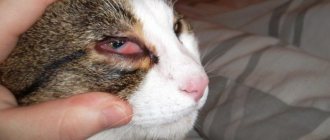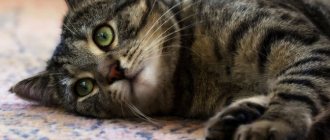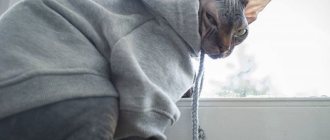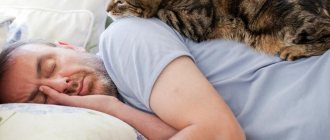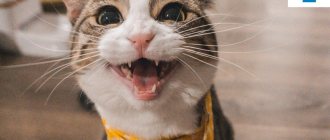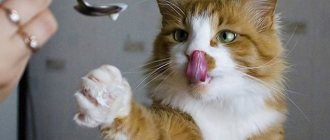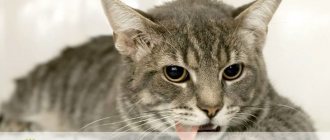The cat really loves to eat packaging bags, tears them to shreds and eats them, even pulls them out of the bag, maybe she lacks some vitamins? Most often, eating plastic bags is a bad habit formed while living on the street. This behavior is typical for selected cats and can only be combated by hiding the bags from the cat.
Sometimes behavioral disorders also occur in initially domestic, “prosperous” cats, as a response to stress or a consequence of dysbiosis. In this case, it is recommended to eliminate factors that are traumatic to the cat’s psyche, if any, and drink 1 ml of Biovestin for a month. 2 times a day to restore normal intestinal microflora.
How it can be used
Confined space forces a cat to adopt a posture that helps keep it warm
The pet's attachment to boxes and packages can be used to transport a naughty pet to the required place or to fix the purr during weighing if the animal does not want to get on the scales on its own.
So, a cardboard shelter for a cat is not only a place of leisure, but also a way to convey your wishes to a person. Therefore, you should not be angry if your furry pet chose this particular object for his games.
Why do they chew packages?
Plastic packaging attracts pets no less than cardboard packaging. There are times when a pet furiously tears a plastic bag with its teeth. This does not mean that he lacks any substances or is sick. Not at all: if you are sick, have a vitamin deficiency or feel unwell, the cat is not interested in the bag. The animal entertains itself this way, because, you see, the owner often pays too little attention to it.
The cat begins its play by rustling and often by tossing a package. While entertaining herself, she may give in to her predatory instincts, similar to those when she plays with a mouse. Other individuals like the way their claws dig into the polyethylene. If the cat seriously chews or even eats the bag, most likely there was something edible in it, which left an attractive smell for it. For the same reason, the cat licks bags.
Causes for concern
The main danger in a cat's craving for bags is that the animal may inhale a piece of plastic while playing. If a cat has a habit of tearing bags apart, it is better for owners not to leave them within the pet’s reach. It is also worth removing the bags if your cat likes to chew or lick them.
The cat’s habit of hiding in a bag cannot be called harmless, because during the game it can become entangled and suffocate. It is better to offer your pet a regular box for these purposes or purchase a special gaming complex.
Pica - “perversion of taste”
Some cats (we emphasize that they are a minority) happily eat completely inedible things and objects, including plastic bags. The generally accepted term in world medicine for “perversion of taste” is called “pica”. Experts and scientists are divided on the nature of pica. Some experts believe that pica manifests itself solely due to malnutrition; cats lack certain vitamins, elements or minerals. Others believe that pica is simply a consequence of early weaning of kittens from the mother's breast. Time will tell who is right; serious research is still ahead.
What will the doctor advise?
Even an ordinary Christmas tree ribbon can be deadly for a cat who decides to play with it. The material from which it is made may be more dangerous than polyethylene and cause severe intestinal obstruction, but the most dangerous are considered to be Christmas tree rain, ribbons for Christmas decorations, foil or rough paper. Therefore, for safety reasons, do not leave your cat unattended where there is a Christmas tree or bags of food or leftover food. If the cat has eaten cellophane, do not try to remove it completely, as this may damage the esophagus or a piece of cellophane will get stuck in the throat and may cause suffocation. You should not give a laxative, as it will worsen the effect; consult a veterinarian.
After examining the cat, he will prescribe an ultrasound and x-ray. These studies will help determine the localization of polyethylene and the general condition of the cat’s body. In some cases, a study with a contrast agent is required. If the animal has a severe case and necrosis of intestinal tissue has begun, surgical intervention will be required. If there are underlying medical conditions or if the cat is over 7 years old, this can be very risky, so it is worth preparing for any outcome. If the x-ray does not confirm intestinal obstruction, and the foreign body does not injure the internal organs, the doctor will most likely prescribe a diet. The cellophane will come out along with the stool.
If the package is stuck in the intestines, a rich and dense diet is required. Under no circumstances should you try to interfere with this process on your own, especially if the cat has eaten a large piece of a plastic bag. In this situation, it is better to contact a veterinarian. Even if a string is stuck in your cat's intestines, do not remove it as it may damage the intestines. It can pass out of the cat’s body with feces on its own, or this will require the intervention of a specialist.
Preventive measures
If a kitten or cat appears in your house, then you need to know what to do so that it does not eat the fish along with the cellophane..
- Do not throw away the skins of sausages, sausages, bags in which fish or meat was stored in places accessible to the cat. Keep trash bags out of your cat's reach. To prevent your cat from eating the skin of a hot dog or sausage, throw it away in a special bag that will be stored in an inaccessible place. Store used cat food bags there too;
- If there is a Christmas tree in the room, keep an eye on your pet. To prevent the kitten from eating the rain and tinsel, hang it high from the floor, do not let him play with it;
- Remove ribbons and threads, especially knitting ones, so that the cat does not eat them, especially if the day before you noticed that he ate a rag or paper;
- Do not allow the cat to eat a bag that smells of valerian, or blisters for sedatives that contain this herb. Cats often lick things that have come into contact with valerian and can swallow them.
Remember that your pet's health is in your hands. And his well-being, and in some cases his life, will depend on your vigilance and attentiveness.
Why do cats like bags?
Cats lick plastic bags for a number of reasons.:
- The simplest option is that a plastic bag retains the smell of the product that was wrapped in it. In the case of meat and dairy products, the increased interest in used packaging on the part of curious pets is easily explained.
- Your cat may have tooth or oral pain. By chewing a soft bag, the pet tries to relieve discomfort.
- Biodegradable bags are made on the basis of starch; animals may be attracted by the smell, although it is imperceptible to humans.
- To prevent the bags from sticking together during storage and transportation, they are treated with so-called “sliding agents.” Typically, it is stearic acid, which is obtained from animal fat. In this case, a curious cat may be attracted by the smell of the bag.
- The structure of the bag is smooth and cool; in the warm season, the animal may simply enjoy lying on such a surface.
- The rustling sound can attract animals, especially kittens.
- Stress can cause your cat to become more interested in bags. If a pet is in an unfavorable environment and does not feel safe, then this may be the impetus for increased interest in cellophane.
- A cat or cat is trying to entertain itself. When a pet is alone for a significant part of the time or left to its own devices, the owners do not pay attention to it and do not play with it, then the animal very quickly finds a way to entertain itself.
Thus, a plastic bag as a toy is not a signal of the onset of pathological processes in the animal’s body, but banal loneliness or curiosity. In rare cases, this may be due to health problems.
Odor storage
And again we return to plastic bags. They are made from a polymer material, the gaseous hydrocarbon ethylene. These bags have the amazing property of absorbing all odors (especially the odors of the contents). For example, you buy food in a supermarket - fish, chicken, meat, etc. All this is wrapped in polyethylene. At the checkout, purchases are packaged in another, “large” branded bag. As you know, cats have a sensitive sense of smell. All the plastic packaging containers managed to become thoroughly saturated with food on the way home from the store. The logical result is the purr’s increased interest in the packages you brought.
Absolutely forbidden!
If you notice that a cat has swallowed polyethylene, then under no circumstances should you help him get rid of it. You should not give your animal drugs that cause vomiting or laxatives; the notorious Vaseline oil for cats is also highly taboo! This can significantly aggravate the situation and harm the cat. If you deliberately induce vomiting in a cat, there is a high probability of the bag getting stuck in the throat and, as a result, suffocation of the animal.
All laxatives and oils are dangerous because in case of intestinal obstruction, under their influence the intestines will become even more clogged and the pet’s condition will worsen. Self-therapy and attempts to alleviate the cat’s condition with intuitively selected medications, in many cases, end in an emergency visit to the veterinary clinic and the possibility of surgery.
If you are one of the lucky ones and everything is fine with the cat after such a feast, you shouldn’t rejoice ahead of time either. There is a possibility that when trying to go to the toilet, the animal may get this same polyethylene stuck in its anus. Under such circumstances, you should also not “help” the cat on your own. You should not try to pull on a piece of the bag that is visible to you; you can damage the mucous membrane and gastrointestinal tract of your pet. It is better to contact a specialist who, using special devices, will painlessly and quickly remove the foreign body from the rectum.
When to see a doctor
A cat eats something inedible not always in front of its owner. Therefore, it is impossible to immediately discover what happened. You need to focus on your pet's behavior. Small, delicate things independently leave the body through the gastrointestinal tract. This usually takes up to 3 days. The cats do not show what happened in any way, eat well, and behave actively.
Alarming symptoms:
- increased salivation – due to blockage of the esophagus;
- cough, wheezing, blue tongue - when localized in the pharynx;
- restlessness, neck craning, hunched back;
- abdominal pain, bloating, accumulation of gases;
- lethargy, apathy, weakness, inactivity;
- vomiting with belching, problems with bowel movements;
- lack of appetite, thirst, exhaustion of the body.
The listed signs appear with the development of obstruction and damage to organ walls. If the condition does not return to normal within 3-4 days after the cat ate the money or hair elastic, the veterinarian decides what to do. The owner needs to get the pet to the clinic as quickly as possible.
This is interesting: Why do cats cry?
Host actions
A natural question arises: what to do if a cat licks itself after castration? First of all, to avoid licking a wound, you need to take care of your pet from a moral point of view. It is important to protect him from stress, not to scold him, to stroke him more often, and to take good care of him. This will allow the pet to calm down a little and stop trying to heal itself.
Of course, it is advisable to use special means to prevent licking:
- Special collar. There are funnel-shaped plastic models on sale, but you can make such a device yourself. The material should be quite rigid so that the cat cannot damage it - for example, thick cardboard will do. A circle is cut out with a hole in the middle. Then an incision is made on one side, and after securing the collar around the cat's neck, it can be sealed with tape or secured in another suitable way.
- Diapers. Regular children's smallest sizes will do. For convenience, a hole is cut in the back for the tail. It must be remembered that you should not keep your pet in them all the time, so as not to infect the castration site. Diapers can be used for a short time at moments when the cat licks the seam after castration especially actively.
Such isolation methods may cause additional inconvenience, but will help to avoid seam dehiscence and the development of infection.
If, in addition to licking, there are other warning signs, you should consult a doctor for advice. Even if the alarm is false, it is better to play it safe to avoid serious consequences for the animal’s health.
Castration of animals is a simple surgical operation that involves removing the gonads in males and stopping reproductive functions. The operation is performed in a veterinary clinic or at home under general or combined anesthesia. If all rules are followed, animals do not experience any serious complications after castration. Moreover, the duration of the postoperative period largely depends on the correct actions of the owners. After the procedure, you need to pay attention not only to the health of the fluffy, but also to monitor the condition of the postoperative area. If a cat licks himself after castration and does it furiously and intensely, sutures may come apart. Bacteria can enter the wound, causing suppuration and causing acute inflammation.
"Play with me"
During their games, cats simply love to lick each other. By this, among other things, they say that they do not hold any stones to their hearts and completely trust their partner.
The exact same motivation drives our pets when they start licking a person.
If your cat licks your fingers, looks sweetly into your eyes and literally trembles with impatience, then most likely she expects reciprocity from you, wants you to play with him.
However, we humans do not often pay enough attention to our little ones and do not share their interests, in which case licking hands is the only thing left for the cat.
What do you like about boxes?
In the eyes of a cat, a cardboard box can become a refuge or an object for play. Often cat owners use this packaging to create large play complexes. However, the cat does not necessarily need the box to be lined with warm material. If she likes it, it will be her favorite subject, taking up a lot of her free time.
The smell of childhood
Some believe that the reason for the interest may lie in the relationship between cardboard and wood. It is likely that the cat smells the native smell of wild nature. However, a more plausible version is her childhood memory: as a kitten, she was with her mother in a cozy box. And therefore he can remember the smell.
What to do?
In this situation, the doctor may consider it necessary to perform an ultrasound on the animal. When visiting a veterinary clinic, the doctor will send the cat for an ultrasound and x-ray. Using these techniques, it is possible to identify the location of the package and determine the state of the pet’s body. If necessary, radiography is performed using a contrast agent. In some situations, ingestion of the package causes necrosis of intestinal tissue. If this condition has been diagnosed, surgical intervention is mandatory. It is unsafe in elderly animals and in the presence of concomitant diseases. If the results of the examination did not reveal intestinal obstruction and the bag does not injure the internal organs, the veterinarian often prescribes a diet that helps quickly safely remove polyethylene from the body along with feces.
Why plastic?
Fuzzies love it. Plastic bags appeal to different senses: the crunch of plastic excites the cat’s ears, the smell of food that was previously in the bag wafting through the air tickles the nose, and the smooth surface under the paws is pleasant to the touch. It's a complete sensory experience for the little friend.
As Pet Health Network explains, plastic bags are especially popular with pets because “many of them are coated with substances such as cornstarch and stearates (salts of stearate acid), or made from animal byproducts such as gelatin, making them attractive to cats " The cat sees a plastic bag and thinks: “Oh, look, it’s yummy!”
In addition, your pet may chew bags and other harder plastic objects, such as cocktail straws or bottle cap rings, to reduce anxiety caused by psychological or medical stressors. This could be anything from moving to a new home and adding a new pet or child to illness and aging.
Cat is attracted to material
To prevent the bags from sticking together, lubricating chemicals are added to them during production. They contain stearic acid obtained from animal fat. And some members of the cat family really like the smell and taste of these substances.
Currently, manufacturers have begun to produce biodegradable bags. Corn starch is used as a raw material. Cats may also like it.
Well, we should not forget that a pet may be attracted by the color or shape of the package.
Is it safe to lick the bag?
Licking the bag is not dangerous as long as the owner or mistress is looking after his furry pet. Of course, it is important that the bag is clean.
You should be concerned when your pet starts chewing plastic. Chewing can lead to swallowing, which can even cause blockage in the gastrointestinal tract.
If you are concerned that this behavior will go unnoticed, it may be better to ban "relationships" with polyethylene altogether. Instead, explore safe alternatives to help your cat satisfy her licking and chewing needs. For example, you can offer the animal catnip or toys.
Based on materials from www.litter-robot.com
"Mortal boredom"
When a cat has accumulated a lot of energy during the day, the animal will definitely find something to occupy itself with. For example, why not lick the bag? This is how the pet tries to entertain itself.
To prevent this from happening, you need to keep your pet occupied with something during the day so that he can expend energy and have a good rest at the end of the day.
How to wean from playing with bags and licking
Although the factors considered do not indicate any pathologies in the body of cats, they may well cause these pathologies, and here the solution is clear - cats need to be weaned from chewing bags. For this purpose, quite understandable and accessible methods can be used.
- Do not leave cellophane in front of cats. Just don't create situations where cats can get to the plastic.
- Check your teeth. It is quite possible that chewing is caused by some problem in the oral cavity. Then you need to go to the vet.
- Buy exercise equipment. You know how children can sometimes play with a stick or dirt and, as a rule, they do this not because of the special value of these substances, but because of the lack of an alternative. Cats also turn to chewing and rustling plastic simply for something more interesting. Therefore, buy exercise equipment for your pet with ladders and ropes, and he will most likely not remember playing with a plastic bag at all.
- Pay attention to the animal's behavior. Cats can get lonely too, although they look like proud wanderers in this world enjoying themselves, in reality they need your attention. Spending some time with your cat relieves stress, which can lead to chewing plastic, and is also a useful leisure activity for you that will distract you from everyday worries.
One way or another, as soon as you notice a tendency to eat plastic, you should find out the reason for this behavior and, if possible, eliminate the habit itself. After all, we are not just talking about basic order, but also about the health of your pet. An animal can simply die from an excess of cellophane if this material ends up in the body.
the cat hides in dark places - why and what to do?
What to do if the cat ate the bag?
Is this situation dangerous for his life or health or not and is it worth contacting a veterinarian? Here's what modern experts write about it.
Should I worry?
From time to time, cats may eat sausage rinds, Christmas tree decorations, or bags containing meat or fish products. If the piece of polyethylene is small, then there is nothing wrong with that. It leaves the body on day 3-4 along with feces, without causing significant harm to the animal. Under natural conditions, cats can eat non-food fibers, which they use to cleanse their stomachs, so it is not surprising that they chew rags, bags and inedible things. Veterinarians advise that if cats start eating bags, bring them grass that has not been treated with chemicals, soft chicken bones or special solid food for animals, which is best selected together with a veterinarian.
Even if a cat, like a dog, eats a large inedible object, it will vomit it. It will not penetrate the intestines and will help the animal cleanse its stomach. It is worth observing the behavior of the animal for 3-4 days. If it hasn't changed, there's nothing to worry about. But if after consuming the package you notice the following symptoms, you should immediately contact the clinic, even if the cat ate a small piece of cellophane :
How to stop a cat from playing with bags
If a cat likes to play with bags, there is no point in scolding or punishing her for it. The animal is instinctively attracted to rustling or interestingly smelling objects, and the cat is unlikely to comply with the ban when you are not around. Moreover, stress can negatively impact your relationships.
It is better to remove all bags away from your pet, and as an alternative, offer the cat rustling toys, teasers, cardboard scratching posts and boxes. To increase your pet's interest in new accessories, you can apply a couple of drops of catnip extract to them.
Soft polyethylene relieves toothache
Chewing may be a way to relieve pain. If a cat has dental or oral diseases, then it instinctively begins to lick or chew soft plastic bags, trying to get rid of pain.
In addition to dental diseases, other reasons can lead to the desire to “feast” on bags:
- state of stress (change in family composition, renovation, moving to a new place);
- poor nutrition;
- Digestive problems (hairballs stuck in the stomach).
